By Dr Julian W Tang
Honorary associate professor and clinical virologistrespiratory sciences, University of Leicester
SO, A Covid-19 vaccine has finally arrived in the form of a new mRNA type of vaccine, from Pfizer-BioNTech (a US-German collaboration). But there is not a lot of it yet and the question right now is, who gets it first?
The UK government has already published a list* of those prioritised to receive this precious vaccine. Top of the list are “residents in a care home for older adults and their carers”. Interestingly, no specific age is given in this category, which seems to imply that if you are in a care home, as long as you are an ‘older adult’ (which could mean anyone over 65) you will receive the vaccine first. Immunising their carers makes sense as they will have the most contact with the residents and, if not protected, could then infect the adults they are caring for.
Next in line are “all those 80 years of age and over and frontline health and social care workers”. This implies these are the over-80s not in care homes – so perhaps living in their own homes or with extended family. The frontline health and social workers are a separate category and so presumably will be the clinical teams in the emergency departments and the wards seeing and admitting Covid-19 patients into hospitals; or any other mobile care teams seeing suspected Covid-19 patients in the community.
After this, the priority decreases with younger age groups from 80 down to 50 years old, with some additional parallel prioritisation at “70 years of age and over”. This includes the “clinically extremely vulnerable individuals” – patients who have been ‘shielding’ during the pandemic, who usually have some degree of immuno-compromise. This is a reasonable precaution, though interestingly several studies in transplant patients have not shown that Covid-19 increases their mortality, where their underlying disease has been relatively stable.
The next checkpoint is at 60-65 years, which includes “all individuals aged 16-64 with underlying health conditions which put them at higher risk of serious disease and mortality”. These are listed as: diabetes, obesity, cancer and the immuno-compromised, chronic lung, heart, kidney, liver, neurological diseases and those with severe learning disabilities. This is similar to the high-risk list of patients who are urged to get the flu jab each year, with some notable omissions (no pregnant women or children for the Covid-19 vaccine), and some additions – specifically those with ‘severe mental illness’.
There is a specific section related to “Mitigating inequalities” in the document, with a reference to ‘Annex A’** that details the rationale behind the section. Both are carefully written texts that attempt to separate the science from the emotional hype and trauma that has surrounded the BAME vulnerability to Covid-19 in the media. They essentially say that BAME individuals exhibiting these comorbidities will be prioritised for vaccination (within the vulnerable 16-64=year age groups) because of these existing medical conditions, rather than their ethnicity. Theoretically, this should cover those vulnerable members living in multi-generation households – if grandparents and parents are vaccinated due to their ages and any accompanying comorbidities, they should be protected against the virus if their grandchildren or children become infected and bring it back from school, for example.
However, ethnicity may matter if there are undiagnosed vulnerabilities in some younger members of the family that have not yet manifested, and these may be more prevalent in BAME populations due to their cultural history and heritage. Similarly, a few studies have shown that vaccine-induced immunity may vary across different ethnicities, with some being slower to react with lower levels of immunity induced than in others. This has been particularly well-documented for the MMR (measles-mumps-rubella) live-attenuated vaccine.
We do not yet know if this applies to the various Covid-19 vaccines, but hopefully, with so many different types of vaccines now under development, some will work better than others in certain BAME and non-BAME individuals.
The BAME population’s vulnerabilities and higher Covid-19 morbidity and mortality are not generally seen in the countries from which these populations originate (despite the various testing and reporting issues within those countries).
The Worldometer Covid-19 statistics (www.worldometers.info/coronavirus/) are widely used to track Covid-19 cases globally and are reasonably reliable based on the data available from the various countries. Examining the Covid-19 figures for India, Pakistan, Bangladesh, various African countries and those with Chinese and other Asian populations do not show the degree of morbidity and mortality seen in immigrant BAME populations in the UK and the US.
Certainly, immigrant Asian ‘foreign’ workers in Singapore are not showing such high degrees of morbidity and mortality from Covid-19.
The vaccine will not correct any of the long-standing socio-economic immigrant issues in BAME populations in the UK, but if the roll-out of the vaccine really, truly sticks to the prioritisation set out in these guidelines (and we know that often what is written is not always followed in practice), the Covid-19 vulnerabilities in the BAME populations should be mostly covered.
















 Heehs describes two principal approaches to biographyAMG
Heehs describes two principal approaches to biographyAMG



 David Beckham wearing a David Austin Roses "King's Rose" speaks with King Charles III during a visit to the RHS Chelsea Flower Show at Royal Hospital Chelsea on May 20, 2025Getty Images
David Beckham wearing a David Austin Roses "King's Rose" speaks with King Charles III during a visit to the RHS Chelsea Flower Show at Royal Hospital Chelsea on May 20, 2025Getty Images
Guidance on Covid vaccine for BAME communities ‘tried to separate science from emotion’